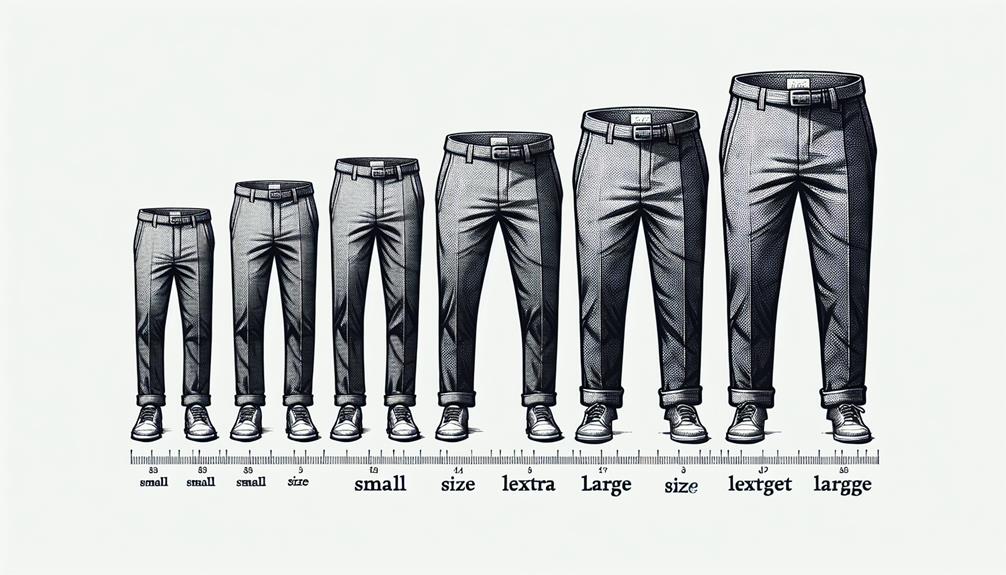Exploring the Men's Trouser Size Chart reveals a detailed breakdown of measurements and fits to assist in selecting the ideal pair of pants.
As I navigate through the intricacies of waist sizes and inseam lengths, the nuances of various cuts and rises further pique my interest.
Understanding how these elements interplay is vital for achieving a tailored look.
The nuances of finding the perfect fit are vast, but with the right guidance, mastering the art of trouser sizing becomes a rewarding endeavor.
Table of Contents
Key Takeaways
- Men's trouser sizes range from 26 to 40 inches in waist sizes, with various inseam lengths available.
- Understanding W/L sizes is crucial for finding the right fit; round up to the nearest inch for precision.
- Different cuts like slim fit and bootcut cater to various preferences, ensuring a tailored look.
- Consider body type when choosing fit types like slim, regular, or relaxed, for the perfect trouser fit.
Trouser Size Measurement Basics
When I measure trouser size, I start with the waist width and inseam length. Understanding these key measurements is important for finding the perfect fit in pants sizes.
Men's trouser sizes are typically determined by waist sizes ranging from 26 to 40 inches. Additionally, inseam lengths come in options like short, regular, long, and extra long to accommodate varying heights. Different trouser cuts such as slim fit, regular fit, relaxed fit, and bootcut offer a range of styles to suit individual preferences.
To make sure the best fit, it's important to know your waist and inseam measurements accurately. The waist measurement is taken around the natural waistline, which is typically the narrowest part of the torso. On the other hand, the inseam measurement is taken from the crotch to the bottom of the leg.
Understanding W/L Sizes
Understanding W/L sizes in men's trousers involves interpreting two numerical values that indicate the waist width and inseam length, respectively. The first number on the Size Chart signifies the waist width, while the second number represents the inseam length in inches.
It's essential to note that W/L sizes are consistently specified in inches, offering the convenience of converting to centimeters by multiplying by 2.54. When determining the appropriate W/L size, always round up to the nearest inch to guarantee a precise fit.
Mastery of W/L sizes is fundamental in selecting trousers that not only fit comfortably but also maintain proper proportions. By grasping the significance of these two numbers on the Size Chart, one can navigate the world of men's trousers with confidence, ensuring a tailored and flattering appearance that aligns seamlessly with individual body measurements.
Waist Size Measurement Method
When measuring my waist for men's trousers, I start by using a measuring tape above my hips, ensuring it's parallel to the ground.
Standing in front of a mirror helps me achieve accuracy in determining my waist size.
Remember to jot down the waist measurement in inches for easy reference when selecting the perfect fit.
Waist Measurement Basics
To determine your correct pant size, start by accurately measuring your waist. Here are some key points to make sure when measuring your waist size:
- Use a flexible tape measure: Make sure the tape measure is snug but not tight around your waist for an accurate measurement.
- Measure at the narrowest part of your waist: Locate the natural indentation above your hip bones to find the narrowest part of your waist.
- Keep the tape level: Make sure the tape measure is parallel to the ground to prevent an inaccurate reading.
- Take measurements in inches: Waist sizes for men's trousers are typically given in inches, so it's important to use this unit of measurement for accuracy.
Finding the Right Fit
For accurate fitting men's trousers, start by measuring your waist size using a measuring tape positioned above your hips and kept parallel to the ground. Stand in front of a mirror to make sure precision when determining your waist size. Recording this measurement is essential for choosing the right size when shopping for trousers.
If you have old pants that fit well, they can give you a rough idea of the waist size you should be looking for. Remember, the waist size is a critical factor in determining the proper fit of men's trousers, so getting an accurate measurement is key to finding the right size.
Tips for Accuracy
To guarantee accurate waist measurements for men's trousers, position the measuring tape above your hips, keeping it parallel to the ground.
Stand in front of a mirror to make sure the tape is straight and not twisted around your waist.
Make sure the measuring tape is snug but not too tight against your skin for precise measurements.
Note down the waist size in inches or centimeters for future reference when selecting pant sizes.
Consider using your old pants as a reference point to determine your current waist size accurately.
Accurate waist measurements play a crucial role in choosing the right sizes and ensuring a comfortable fit when selecting men's trousers.
Inseam Length Measurement Technique
When measuring the inseam length of men's trousers, start from the crotch and extend down to the hemline for accurate sizing. This method guarantees precision, especially when dealing with different inseam options like Short, Regular, Long, and Extra Long.
Remember, inseam length is important of waist size in men's pants, so it's vital to measure each separately for the perfect fit.
Additionally, take into account the type of shoes you intend to wear with the pants, as this can affect how the trousers fall on your leg.
If you're unsure about your inseam measurement, look at the labels on well-fitting old pants to guide you.
Exploring Common Pants Cuts
I've come across various common cuts for men's pants, each offering a distinct style and fit tailored to different preferences and body types. Understanding these cuts can help you choose the perfect pair of pants that not only look great but also provide the comfort you need from crotch to ankle.
- Baggy: This cut offers a loose and relaxed fit, providing ample room for movement and a laid-back style.
- Slim Fit: Designed to hug the legs without being too tight, the slim fit cut creates a sleek and modern look.
- Regular: A versatile option that falls straight from the hip to the ankle, suitable for various body types and occasions.
- Boot Cut: This cut is slightly flared from the knee to the ankle, allowing for easy accommodation of boots while maintaining a classic silhouette.
Each of these cuts caters to different preferences and body shapes, so choosing the right one can elevate your style and ensure a comfortable fit.
Summary of Men's Pants Sizing
Having explored common pants cuts that cater to various preferences and body types, understanding the summary of men's pants sizing is essential for selecting the perfect fit. To make sure you find the correct size, refer to the following table summarizing men's pants sizing based on waist measurements:
| Size | Waist (inches) |
|---|---|
| XS | 26-28 |
| S | 29-31 |
| M | 32-34 |
| L | 35-37 |
| XL | 38-40 |
These sizes correspond to the waist measurements in inches, which are the primary determinant of men's pants sizes. By identifying your waist size accurately, you can choose the correct size that guarantees comfort and style in your pants. Remember that inseam lengths also vary, offering options like Extra Short, Short, Regular, Long, and Extra Long to accommodate different heights and preferences. Selecting the right waist and inseam measurements is vital for achieving the perfect fit in men's pants.
Men's Trouser Sizing FAQs
Exploring frequently asked questions about men's trouser sizing sheds light on essential details for selecting the right fit. When browsing the vast array of sizes and styles available, understanding the nuances of men's trouser sizing is important. Here are some key queries often encountered regarding men's trouser sizing:
- How do I determine my waist size accurately for men's trousers?
To find the right waist size, measure around your natural waistline, typically located just above the hip bones. Refer to the brand's size guide for specific measurements.
- Are inseam lengths standardized across all brands for men's trousers?
Inseam lengths can vary between brands and styles. Be sure to check the size guide provided by the brand to determine the inseam length that suits your height and preference.
- Do men's trousers with the same waist size have the same fit?
Not necessarily. Different cuts and styles, such as Slim fit, Regular fit, and Bootcut, can impact how trousers fit around the legs and seat, even with the same waist size.
- Can I alter the length of men's trousers if needed?
Yes, many tailors offer services to adjust the inseam length of trousers to achieve a perfect fit. However, make sure the trousers have enough fabric to be lengthened if required.
Tips for Finding the Perfect Fit
When looking for the perfect fit in men's trousers, it's essential to ponder your body type, focusing on aspects like waist size and inseam length. Different rise options and fit types cater to varying preferences, providing options for style and comfort.
Utilizing conversion charts can also aid in maneuvering international sizing for a more accurate selection process.
Fit for Body Type
Considering your body type can greatly impact how your trousers fit and complement your shape. When looking at men's trouser size charts, choosing a fit that suits your physique is crucial for both comfort and style. Here are some tips to help you find the perfect fit based on your body type:
- Slim Fit: Opt for a tailored look that follows your body's contours for a modern and sleek appearance.
- Regular Fit: Choose this option for a standard, comfortable silhouette that works well for most body types.
- Relaxed Fit: If you prefer a loose, laid-back style with extra room, a relaxed fit is the way to go.
- Athletic Fit: Ideal for those needing more space in the seat and thighs while maintaining a tailored appearance.
Length and Waist
To guarantee the ideal fit of men's trousers, understanding both the length and waist measurements is essential. When it comes to selecting the perfect pair of men's pants, paying attention to these key measurements can make all the difference. Here is a breakdown of common waist sizes and inseam lengths to guide you towards finding the best fit for your body:
| Waist Size (inches) | Inseam Length (inches) | Fit Types |
|---|---|---|
| 28-46 | 30-36 | Slim, Regular, |
| Relaxed, Athletic | ||
| Bootcut |
Frequently Asked Questions
What Size Is a 32 in Men's Trousers?
A size 32 in men's trousers typically fits a 32-inch waist. It's essential to take into account inseam length variations across brands. For waist measurements around 31-33 inches, a size 32 often provides a good fit.
What Does 32×32 Pants Size Mean?
A 32×32 pants size means the waist measures 32 inches and the inseam length is 32 inches. It's a common size for men's pants, fitting waists around 31-33 inches. This size is versatile and easy to find.
What Size Is 34 Regular Trousers?
Size 34 regular trousers typically correspond to a 34-inch waist and 32-inch inseam. They are regarded as a standard size in men's clothing. When picking them, it is crucial to factor in fit and style preferences for the best look.
What's a Size 34 in Men's Pants?
A size 34 in men's pants generally corresponds to a waist measurement of about 33-34 inches. It's a common size found in stores and offers a comfortable fit. Various inseam lengths like 30, 32, or 34 inches are often available.
- Tetron Fabric Vs Other Fabrics: a Comparative Analysis - June 17, 2025
- Creative Uses for Tetron Fabric in Fashion and Home Decor - June 17, 2025
- Tetron Fabric HS Code: Import and Export Information - June 17, 2025







